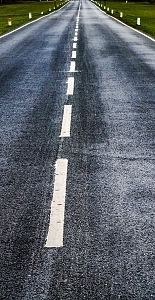Adam Yamey's Blog: YAMEY, page 140
December 27, 2021
Mahatma Gandhi in Hampstead
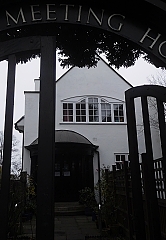
WHEN I USED TO visit Hampstead with my parents in the early 1960s, we always walked past a place that intrigued me when I was a youngster. It was the still standing Hampstead Quaker Meeting House, which has a lovely front garden. The latter is overlooked by its neighbour, the late 18th centuryMansfield Cottage, which in the 1960s housed a tearoom or restaurant. The Meeting House with art nouveau (Arts and Crafts) features was built in about 1907 to the designs of Fred Rowntree (1860-1927). According to James D Hunt in his detailed book “Gandhi in London”, Mohandas K Gandhi (1869-1948), the future Mahatma, spoke in this meeting house on the 13th of October 1909:
“… perhaps travelling there by the recently opened underground line … The Society of Friends (Quakers) were not at this time much interested in Indian affairs … The 1909 meeting was sponsored by the Hampstead Peace and Arbitration Society”
The speech, as recorded by Robert Payne in his “The Life and Death of Mahatma Gandhi”, was entitled “East and West” and outlined the evils of the British occupation of India and the sufferings of Indians in South Africa. I knew nothing of this or about the house when we used to stroll down Heath Street.
December 26, 2021
Passage of time
December 25, 2021
Blood on the Page
HAPPY CHRISTMAS !
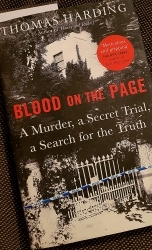
I WAS THE EDITOR of the newsletter of the Anglo Albanian Association (‘AAA’), when a writer, Thomas Harding, sent the following email in late 2016:
“… I am researching the life of Allan Chappelow, a former member of Albanian Society and Anglo-Albanian Association. My former books include ‘Hanns and Rudolf’ and ‘The House By The Lake’. I would welcome hearing from anyone who remembers or has stories about Allan Chappelow…”
I had already heard of the two books and seen a little bit of correspondence about Chappelow, which suggested to me that he was a mysterious fellow. He interested me because he had been a member of one of the earliest groups to visit Communist Albania soon after the end of WW2 and he was a participant in the first student tour of the USSR made after Stalin had died.
Thomas Harding published his book, “Blood on the Page” in 2018. The secretary of the AAA and I attended a launch of this publication in Daunt’s bookshop in Hampstead’s South End Green. The book is about Chappelow, and I have only just finished reading it, having purchased a copy only recently.
Chappelow (1919-2006) lived and died at number 9 Downshire Hill, a lovely Georgian house in Hampstead. Sometime in May or June 2006, he was brutally murdered in his home. His rotting body was only discovered many days later after a bank had been investigating some irregularities in his account and had been unable to contact him. Wang Yam, a man of Chinese origin was accused of, and found guilty of, his murder and stealing his identity to carry out fraudulent financial transactions. All of this is detailed in Harding’s un-put-down-able book, which reads like a good thriller. In addition, Harding describes the trial of the man accused of having been the murderer.
The trial of the accused, who now languishes behind bars, was unusual for a murder case. Some of it was held ‘in camera’ for reasons that have never been disclosed and cannot be, without risking contempt of court. Trials are usually held ‘in camera’ either to protect national security interests and/or to protect the identity of witnesses. Chappelow’s was the first ever murder case to have been held ‘in camera’ in the UK. Why this was the case was not revealed in Harding’s wonderful book. It is clear from his text that he was not privy to the reason for the secrecy. As I read the book, I kept wondering what it is that the government wants to keep secret. From the detailed account of the murder and what Harding was able to find out about it and the 86-year-old victim, by then a recluse, I could not detect anything that could have been a threat to national security
One possible reason for the secrecy during the trial is mentioned in an article in “The Observer”, published on the 25th of January 2018 (https://www.theguardian.com/news/2018/jan/25/murder-in-hampstead-did-secret-trial-put-wrong-man-in-jail-allan-chappelow). Here is a relevant extract:
“Before, during and after the trial, the government went to extraordinary lengths to ensure that details of Wang’s links with MI6 would remain secret. Two cabinet ministers told the trial judge that Wang’s entire defence must be heard behind closed doors. A contempt order issued by the judge prevents the media from speculating about the reasons for the secrecy.”
Elsewhere, the article mentioned:
“Between his arrest and the start of the trial, it emerged that Wang had acted as an informant for MI6 in London for a number of years. Wang was well placed to be an informant for Britain’s foreign intelligence agency. He had family links with China’s first communist leaders, he was opposed to repressive measures taken by Beijing, and he was something of a computer expert.”
Chappelow had visited both the USSR and Albania during the height of the so-called Cold War. I first visited Albania in 1984, when the Cold War was still ongoing, and the Stalinist dictator Enver Hoxha still held the country in his repressive grip. Our group included people who, after the trip, revealed that they were not what they had claimed to be while we were in Albania. For example, a lady who told me during our visit to Albania she was an archaeologist revealed to me later that she was really a journalist. At that time, journalists were forbidden from visiting Albania unless invited by the regime. Chappelow revisited Albania in 1993 after the ending of Communist rule. In his book, Harding quotes a member of the AAA, who was on the trip with him. She remembered that he had said he was a teacher, but she never “got to the bottom of his background”. Most biographical notes about Chappelow refer to him as a photographer and an author, not a teacher. That got me thinking, as did recalling an incident from my 1984 trip.
At least one of my fellow travellers told me that after the trip that he had been approached in Tirana discreetly by one of our Albanian tour guides and some of her colleagues. They invited him to become an agent to provide Albania with information about his country, Australia. Remembering this incident, I wondered whether Chappelow’s murder trial was held behind closed doors because his trips behind the Iron Curtain had either not been purely for reasons of tourism, or possibly while he was there, he had been approached by the local authorities as was the case of my Australian travelling companion.
Returning to Chappelow’s visits behind the Iron Curtain, here is something else I noticed in the Guardian’s article:
“Chappelow was the product of an educated, socialist family, whose liberal-leaning father, a successful decorator and upholsterer, had moved to Denmark rather than be conscripted into military service during the first world war. At the end of hostilities, the family returned to London and bought 9 Downshire Hill. Allan grew up in a politically progressive home; his parents were active members of the Fabian Society. At the onset of the second world war, the bookish Chappelow was faced with the same dilemma as his father, as well as his schoolboy hero, George Bernard Shaw, who had refused to fight in the first world war and was strongly opposed to the second.”
Interesting as speculations about whether Chappelow could have been involved with intelligence work might be, we will probably not find out the real reason for the secrecy for many years to come. In any case, this mysterious episode, centred in and around Hampstead, is a good reason to read Harding’s exciting and intriguing book … and possibly you might come up with your own hypothesis about why Wang’s trial was held ‘in camera’.
December 24, 2021
Winter solstice in the park
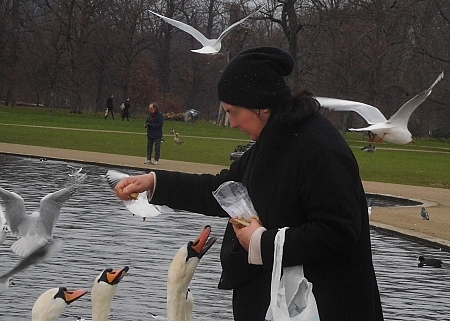
THE TEMPERATURE HAS dropped. Fear of the Omicron variant of the covid19 virus has meant that less people are out and about in London. This was the case in Kensington Gardens today, the winter solstice. The wildfowl that gather around its not so round Round Pond wait eagerly for visitors to distribute tasty morsels. Today, I saw a lady feeding the birds. So many were attracted to her that sometimes her head seemed lost in a cloud of noisy gulls. In front of her, swans extended their necks, attempting to reach her hands. Undaunted, this animal lover continued carrying out her kind gesture.
December 23, 2021
Mistletoe
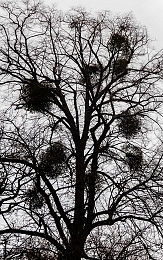
Mistletoes are parasitic plants of the families Loranthaceae,
They feed off growing trees
Give great joy at Christmas
Nature’s two edg’d sword
December 22, 2021
From Madras to Kensington
CAMPDEN STREET IN Kensington is a short thoroughfare running between Kensington Church Street and Campden Hill Road. On it, there is a distinctive building called Byam Shaw House. Until 1990, this edifice with its large centrally placed, north facing window was the Byam Shaw School of Art, which opened in 1910. Named at first as ‘Byam Shaw and Vicat Cole School of Art’, after its founders, Rex Vicat Cole (1870-1940) and John Liston Byam Shaw (1872-1919), it soon became known as the Byam Shaw school.
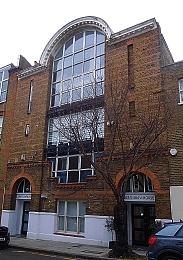
John Liston Byam Shaw is also known as ‘Byam Shaw’. He was born in British India, in Madras (now ‘Chennai’), where his father was registrar of the High Court at Madras. In 1878, the Shaws moved back to England, where they lived in Kensington. At an early age, he showed artistic promise and at the advice of the artist John Everett Millais (1829-1896), he entered an art school in London’s St Johns Wood. As he grew older, Byam’s works attracted less interest and he turned to teaching to earn a living. In 1910, he and Cole founded the art school in Campden Street. Sadly, Byam Shaw died during the great influenza epidemic that followed WW1.
The school in Campden Street has produced several significant artists including Winifred Nicholson (first wife of Ben Nicholson), Bernard Dunstan, Yinka Shonibare, Mona Hatoum, as well as stage designers, stained-glass makers, and actors. The inventor James Dyson also studied there. In 1990, the school moved to larger premises in Archway, and in 2003, the school was absorbed into the Central Saint Martins College of Arts and Design. Byam Shaw would have been pleased to know that his school produced such fine alumni. Guy Burch, who studied at the school between 1981 and 1984, wrote:
“The innovative independent Art School founded in the early 1900s, Byam Shaw had an open studio policy that suited my inability to fit into categories marked ‘painter’ or ‘sculptor’. Most art schools at the time made you choose one or other with cross-media working tending to be discouraged. Their studios allowed you to move between them. I was in the ‘Image Studio’, and worked on collage, painting and mixed media installations.” (http://www.guyburch.co.uk/?p=4358)
I feel it is a shame that the building in Campden Street, which has now become a block of flats, is without any notice commemorating its former use.
December 21, 2021
Guardian dragons
CAST-IRON STATUES of dragons mark the City of London’s boundaries on main roads leading into it., The City includes the oldest part of the metropolis.
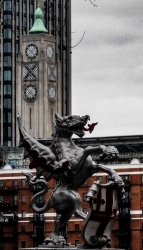
Standing on their hind legs, the dragons stick out their red-painted tongues and rest their left forepaws on a shield with the coat-of-arms of the City of London. The creatures were designed by James Bunstone Bunning (1802-1863), who was architect to the City of London from 1843 until his death.
Thirteen of these dragons can be found in London. Some of them were placed at entrances to the City as late as the 1960s. The dragons are part of the City’s coat-of-arms, which was in use by 1381. In this emblem, a pair of them supports a crest.
I consider that these creatures look far from welcoming.
December 20, 2021
Burgers on the Strand
THE BYRON RESTAURANT chain, which specialises in serving burgers, has a branch next to the Adelphi Theatre on London’s Strand. I have not eaten there but I did peer through its street door. What I saw is quite amazing. The ground floor dining room’s walls have giant mirrors separated by marble pilasters. The ceiling beams look like marble , although it is unlikely that they are made of that material. The grand dining room has a decadent fin-de-siècle appearance, providing your eyes are averted from the banquettes upholstered with red leather, or perhaps plastic, which are quite appropriate for a burger joint.
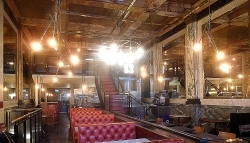
The large façade of the restaurant has pink granite pillars on both sides. On one of these, there is a commemorative plaque that reads:
“Site of the Adelphi Theatre Restaurant owned by the Swiss-Italian Gatti family, restaurateurs, music hall, theatre and electricity supply entrepreneurs. Sir John Gatti served as Lord Mayor of Westminster, 1911-12.”
The Adelphi Theatre is still in business, but its neighbour, the Adelphi Theatre Restaurant, is now the Byron outlet. Carlo Agostino Gatti (1841-1897) and his brother Stefano Gatti (1844-1906), father of Sir John, ran the Adelphi Theatre, the Adelphi Theatre Restaurant and the Vaudeville Theatre all in the Strand (www.londonremembers.com/subjects/gatti-family). Carlo and Stefano came from Ticino Canton in Switzerland. Another Gatti, Gaspare Antonio Pietro Gatti, known as ‘Luigi’, came to London from Montalto Pavese in Italy, where he was born in 1875. He is supposed to have managed the restaurant at The Ritz Hotel, as well its concessions on two ships, one of which was the ill-fated Titanic. Whether Luigi was related to the brothers is uncertain.
What is also uncertain in my mind is whether the dining room that now serves as home to Byron and its burgers is the original that existed when the Gatti family owned the restaurant or whether it is from a later era. The upper storeys of the building were recently converted into luxury flats, whose interiors can be viewed on websites such as https://www.businessinsider.com/pictures-london-gatti-house-millionaire-flats-on-the-strand-with-pizza-lift-2015-10?r=US&IR=T .
So, next time you are wandering along the Strand, take a peek into Byron’s and, maybe, if you are feeling peckish …
December 19, 2021
Old fashioned illumination
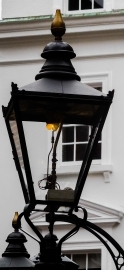 A gas lamp at London’s Middle Temple
A gas lamp at London’s Middle TempleNeither a volt nor an amp
Nor even a wire or a bulb
Will light this gas lamp
December 18, 2021
Art on the roof
TEMPLE STATION IS on the Circle and District lines of London’s Underground. It was opened in 1870 and named after the nearby ancient Temple Church, which stars in Dan Brown’s 2003 novel “The Da Vinci Code”. The station’s ticket office is housed in a single storey building with a flat roof surrounded by a balustrade. The flat roof, with a few benches, occupies about half an acre and until recently served simply as a place to sit in the fresh air. Now, this has changed.
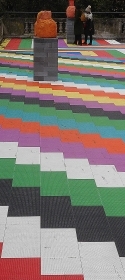
The flat roof has become employed as an open-air exhibition space for young artists. Today (December 2021), we climbed the stairs to reach the roof and were amazed to see that it has been covered with multi-coloured painting and plastic floor tiles, a dramatic sight. There is also a colourful hut, “The Artist’s Hut”, a modern take on the traditional cabman’s shelter. With the title “Back in the Air: A Meditation on Higher Ground”, the art installation was created by London-based artist Lakwena Maciver (born 1986). Also on this coloured space, there are a couple of ceramic works by another artist, Camilla Bliss. It is a wonderful surprise to see this field of bright colours, especially beneath a cloudy, grey sky. It would be fun to see the space from the air. But I do not know whether the pigeons would agree with me.
In the future, it is hoped that other artworks will b e displayed above Temple Station.

